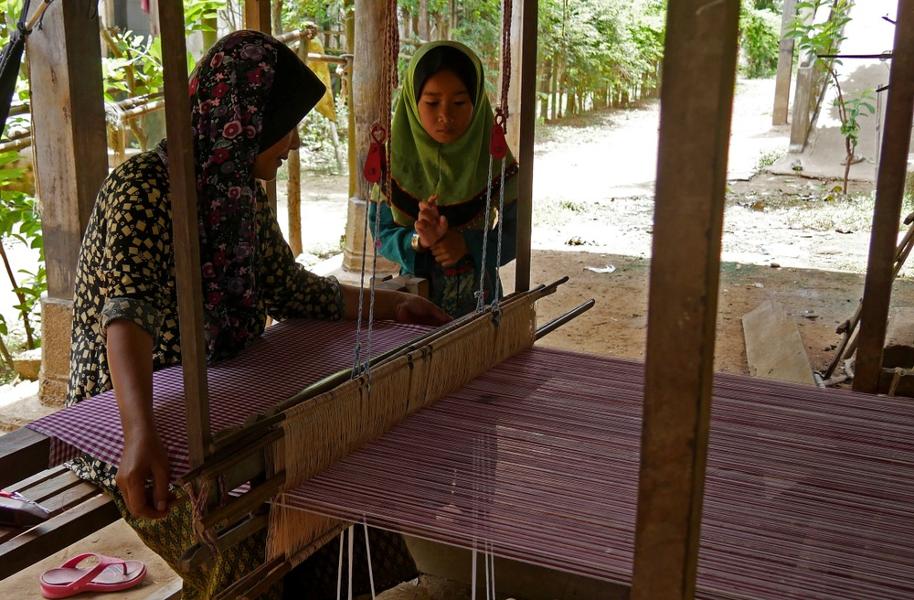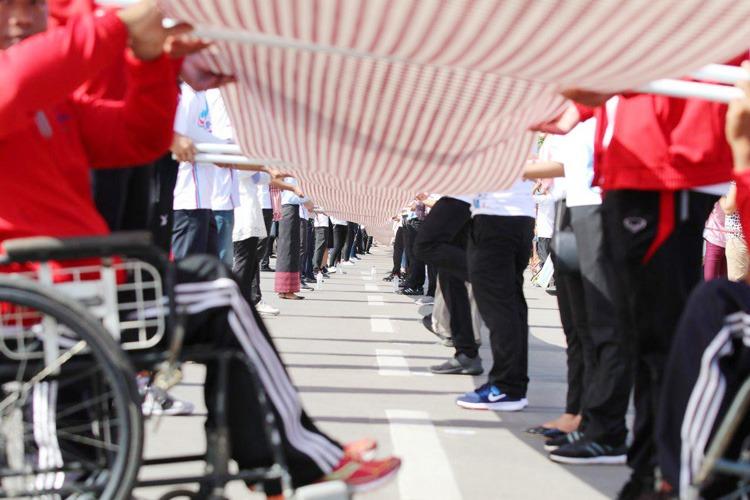Cambodia
The Cambodian Krama
The krama is a symbolic garment of the Khmer people, worn in Cambodia. Traditionally woven from cotton, its pattern consists of colored bands crossing over white stripes, forming a checkerboard of small squares. The most common colors are blue, purple, red, and occasionally green.
Typically measuring between 40 and 70 cm in width and at least 140 cm in length, it can also be larger and used as a sarong, baby carrier, bundle, etc. While the traditional small checkered pattern persists, modern dyes have introduced new colors. Traditionally, each province had its own color, allowing the wearer to be identified at a glance, distinguishing them from Thai or Laotian neighbors, as well as from foreigners in general.
History and the Cambodian Krama
Its historical origins seem to date back to the 13th century, as evidenced by a report from Ambassador Chou Ta-Kuan, sent by Emperor Ming Yongle, describing the garment worn by the people of Angkor.
Since these ancient times, the krama has been worn by everyone—men, women, and children. It is used on numerous daily occasions and serves many other purposes. More than just a piece of clothing, it is an essential accessory for Khmer farmers, offering a wide range of practical uses.

The krama might have disappeared if not for the Khmer people's attachment to this piece of cloth. During the colonial era, when Cambodia was under French protection and part of French Indochina, the country had to comply with European demands to "rationalize" the agricultural system. The French introduced rubber cultivation for rubber production, and although they encouraged cotton farming, it was for export purposes.
Despite this, women were always able to gather enough fibers to feed their traditional looms, called “key.” They tirelessly produced this emblematic fabric at all times and in all places, regardless of the people or political regimes that changed their country and attempted to erase their customs.
In modern times, marked by the tragic era of the Khmer Rouge regime (1975-1979), during which the krama was often used as a symbol of punishment for the condemned, the red-and-white krama is still looked upon with suspicion by the survivors of the massacres. It must be said that the "Democratic Kampuchea" regime forced everyone to wear it as part of their effort to purge the country of capitalist colonial influences and to create a classless society…
The Krama: More than just a garment for the Khmer people

Although the traditional krama worn by the people is made from cotton, for a long time women have also woven silk kramas to supplement their income. Most of the cotton kramas are produced in the Cambodian province of Kampong Cham, on the eastern bank of the Mekong River, while silk is harvested and woven in the southern province of Takéo, near the capital Phnom Penh. These silk kramas are sold to the wealthier population, marking their social status.
In a country where the economy is primarily based on agriculture and standardized textile industry, this modest yet authentic piece of fabric remains highly valued. Due to its lightness in the tropical humid climate, its modest price, and its versatile uses, the krama remains intrinsically connected to the Cambodian people.
Wherever the eyes look, the krama is present. Worn as a scarf or head covering, it provides protection from the sun's harsh rays. Cambodians do not enjoy tanning during the day, and even in intense heat, covering even the smallest part of the skin is vital for the majority of them. Worn widely on the head and shoulders, it shields the bent backs of farmers laboring in the rice fields. Tied like a sarong around the waist, it becomes a skirt worn by both men and women. Sometimes, to make farming tasks easier, men tie it cleverly to create a kind of shorts, providing them with comfort.
It is also often transformed into an apron, protecting a second krama worn directly against the skin before wiping the sweat-covered bodies of farmers returning home. Occasionally, it is stretched between two posts of a cart to serve as a welcome parasol, or it is used as a hammock between two trees.
The country even takes pride in its craftsmanship in krama production. In July 2018, Phnom Penh tailors wove the world’s largest krama, measuring 1,149 meters long and 88 centimeters wide. Although symbolic, this feat highlights the importance of this piece of fabric within the boundaries of Khmer territory.

Its sturdy fabric is often used as a carrier, a makeshift bundle, or even an improvised stretcher. Children have known it since their early age, as it serves as a soft and comfortable baby carrier before becoming their clothing and even a playmate or schoolbag. It still hides the nakedness of bathers who wash in the river, drying their bodies before dressing again, as it dries quickly.
The krama has so many uses that it is too limited to be considered just a scarf or garment. It is, at once, a fabric with many facets and the symbol of an entire people. It is ever-present, from birth to the end of life, and is involved in every task and every moment.

